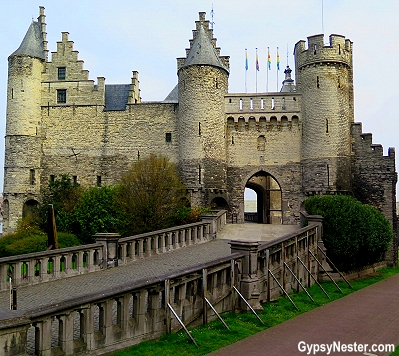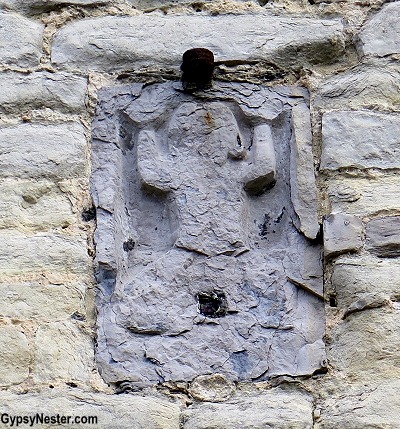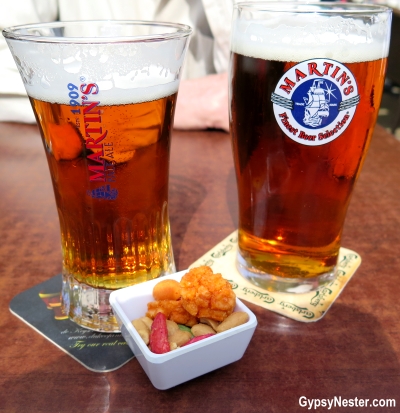
Before visiting Antwerp a thought struck us — maybe the city had something to do with the term twerp.
Our investigation revealed several suggested ideas that we could try to pin on Antwerp.
Perhaps it came from T. W. Earp back in the early twentieth century, or the Low German word for dwarf, Twarg.
Or, according to Kurt Vonnegut, a twerp is someone who shoves false teeth up his rear end to bite the buttons off of the back seats of taxi cabs. Funny, but we found that one pretty unlikely.

We did not find a single reference to the city in Belgium, and didn’t see any reason why there would be, since there is nothing twerpy about Antwerp.
Our Antwerpen adventure began at the Steen, a medieval gate in the ancient city wall.
The Steen, which means stone, is a part of the original thirteenth century fortifications of Antwerp.
The name refers to the foundations, but the defenses were upgraded up until the eighteen hundreds.
They Might be Giants!
Just before entering through the gate, we met the first of the two legendary giants that are said to have terrorized the city through the ages, the Lange Wapper.

While tales of this shapeshifting nuisance go back as far as anyone can remember, the statue depicting Lange Wapper annoying two townsfolk who look to have consumed a bit too much Belgian beer was placed relatively recently, in 1963.
The Castrated Keystone

The keystone of the gate is said to be the oldest artifact in Antwerp, a Roman fertility figure whose manhood has seriously suffered over the centuries.
In the Middle Ages, the city placed the already ancient carving over the entrance as a show of masculinity, but soon women were snatching off bits of his endowment and feeding it to their husbands in hopes of improving their love lives.
Later the Jesuits completely castrated the poor little idol as a statement against the pagan nature of the entire ordeal.
Ouch!
A House of Meat

Once inside the wall, we headed directly into the historic center of the city.
The first building to catch our eyes was the Vleeshuis, or Meat House, which was built in 1504 as the meeting hall for the butcher’s guild.
The claim is that the masonry was made to resemble stacks of bacon by using layers of white stones and red bricks.
We’re thinking that this was perhaps a happy coincidence and took that information with a grain of salt pork.
Oddly, we were craving bacon for the rest of our stay.
Politics as Usual
As we moved into the city center, we found the guild houses that played a big part in Antwerp’s development. These groups of merchants and tradesmen met in ornate buildings surrounding the main square, and were instrumental in the politics of the city for hundreds of years.

Each building is topped with golden statues signifying the business that the guild represented.

They chose to build near City Hall because they petitioned the council for favorable rulings for their businesses.
It struck us that these must have been some of the world’s earliest lobbyists.
The impressive Renaissance-style City Hall was built as a symbol of Antwerp’s power in the city’s golden age.
However, by the time it was completed in 1565, time was running short for this prosperity.
Ten years later Spain took over and the heyday was over.
Lucky for us, the remarkable structure survived.

The Tale of the Severed Hand

The square is also where we met the second of Antwerp’s legendary giants, Antigoon.
It seems that he had the habit of extracting a toll from anyone wishing to cross the river, or cutting off the hand of those who refused and tossing it into the water.
Finally, after years of Antigoon’s antics, a young Roman soldier named Brabo stepped up, slayed the giant.
Turnabout is fair play: Brabo then chopped off Antigoon’s hand and chucked it into the river.

According to the tale, that was how Antwerp got its name, from the Dutch words for hand (hand) and to throw (werpen).
The square in front of the city hall is dominated by an enormous statue depicting Brabo standing on top of Antigoon and holding the severed hand over his head, ready to fling into the river.
There’s also the hand itself further down the road.
No word on whether the Roman hero called the giant a ‘twerp while removing his appendage.

There’s Something About Mary

One square over, we came to the Cathedral of Our Lady.
Actually, at over four hundred feet tall, we couldn’t help but see the church, or at least the tower, all day.
It is the tallest structure in the city, and shall remain so by law.
Construction began in 1352, and ended in 1521, but that one hundred and ninety years wasn’t long enough for the church to be officially completed.

Inside, we found an unusual conglomeration of styles because the church has served as both Catholic and Protestant over the years – often suffering serious damage in the process of converting.
Restorations are continuing, and we were very pleased to find that the altarpieces, The Raising of the Cross and The Descent from the Cross by Belgium’s best-known artist, Peter Paul Rubens, have been returned to their rightful place in the cathedral.

Our guide regaled us with the legend of the giant Lange Wapper and how the wily people of Antwerp thwarted his bizarre mischief. Apparently, one of the shapeshifter’s pranks was to disguise himself as an infant, sneak into homes, and steal breast milk from nursing mothers.
Knowing that Lange Wapper hated the town’s patron saint, Mary, the townspeople affixed statues of Mary on the outside of their buildings for protection.
Everywhere we stepped in the old city we saw these wonderful works of art. The Marys must have worked their magic because we never caught a glimpse of Lange Wapper inside the city gate.

Trains and Diamonds

After lunch we waded deeper into the city.
Lucky for us Antwerp’s a great walking city, so we didn’t need any taxi-seat-button-biting dentures in our bums to go check out the rest.
A leisurely stroll to the Centraal Station took us along the Meir, the city’s main shopping boulevard.
The fantastic domed depot was constructed at the turn of the twentieth century and pays tribute to Belgium’s pioneering history of rail travel.

The country proudly claims to have had the first railroads on the European continent.
The area is also famous for diamond merchants, with about half of all of the diamonds sold in the world passing through at one time or another.

Needless to say these transactions are not public, but there are certainly plenty of jewelry stores along the promenade.
After our walk we were more interested in another of a girl’s best friends, the fabulous Belgian beer.
We grabbed a seat on the sidewalk at The Duke of Antwerp, and ordered a bit of one of the city’s famous brews, Martin’s pale ale.
Our Introduction to Belgian Beer. Hello Belgian Beer!

It didn’t take long to notice that beer is an integral part of life in Belgium.
Nearly two hundred breweries are brewing their brains out in this country that is only about the size of Maryland.
On our way back to the ship we stopped off again at the main square to try two more of those brands.
Our waiter recommended DeKoninck as the perfect example of a local libation, and Tongerlo, which has been awarded as the best beer in the world.
It was there that we observed that each brand of beer must be served in a glass unique to its style and name. Some looked similar to classic German beer steins, but others not so much.

Belgians deem this to be of prime importance, going so far as to refuse a beer if an establishment has the audacity to serve it in the wrong glassware.
We noticed that the DeKoninck was properly representing Antwerp because the logo on the glass featured a detached hand.
As far as the Tongerlo’s claim—it was very good, but we will need to do much more research on fermented beverages from around the world before we are anywhere near ready to declare it the best on the planet!
Here’s to hoping there are no twerps along the way.
Cheers!
David & Veronica, GypsyNester.com
See all of our adventures in Belgium!
Thanks to Viking River Cruises for inviting us along and providing this adventure through the tulips and windmills of Holland and Belgium with stops in Amsterdam, Kinderdijk, Antwerp, Bruges, Veere, Hoorn, and Arnhem.
YOUR TURN:



What a great post, interesting facts too! The architecture and the sculptures are beautiful, the stories make them more intriguing…not quite sure about that lion’s face though… 🙂 This is another I will have to add to my ever growing bucket list! 🙂 Thanks!
I love this! These stories are so fun they really bring Antwerp to life And I simply the love the lion’s expression, even if the artist wasn’t sure what a real one looked like! Thanks so much for sharing!
Our pleasure Lisa, thanks!
I love those old Belgian cities. And I enjoyed reading about Antwerp’s oddities!
I’m still laughing about all those funny stories you included. So fun! That Kurt Vonnegut story was too much. Antwerp certainly looks like a beautiful place to visit – loved your photos.
Thanks Sue! Loved it when I found that Vonnegut definition.
What a wonderful city — and nothing twerpy about it. You guys are too funny. I’ve only seen Antwerp from inside the railway station (and I took a quick peek out the door and down the street) changing trains. It’s absolutely gorgeous. They don’t call it the Railway Cathedral for nothing.
The train station was even better from the outside. Didn’t mean to imply twerpyness, just wondering where the word came from. 😉
I very much enjoyed reading your description of exploring Antwerp. It’s a beautiful city indeed. And you got some beautiful photos of it!
Thanks Rachel!
We were on this Viking cruise and absolutely loved it! Loved your twerp research too!
Thanks Irene, it was fun.
Such a great town and love the legend of Brabo and Antigoon. We ate our weight in chocolate hands when we were there.
We should have loaded up on chocolate severed hands, but I don’t think they go well with beer.
I have never thought about a cruise for a number of reasons- not the least of which is sea sickness. Reading about Viking River Cruises has started to change my mind. For the first time I find myself open to and even wanting to cruise. Your Antwerp time sounds wonderful.
The rivers are usually very smooth. Sometimes you can’t even tell you’re moving.
What fun tales and gorgeous photos! Antwerp’s one of our favorite Belgian cities and you’ve made me eager to return!
Thanks Anne, ours to after visiting.
All that history is so much easier to swallow with a dose of good humor, thank you for that! I’m not sure I can ever hear Antwerp again without thinking of your story, so I guess that’s a very good thing. Now as far as the beer research-do you need an assistant to take notes?
Thanks Alison! Even if we can’t study together, we can continue our independent research.
Having never been to Antwerp, I can’t say I’ve searched for the ‘twerp’ although your pics do the city great justice. I was in Belgium in 1978, working as a groom! Your photos are fun!
Thanks Jo!
Antwerp is beautiful like Bruges and Brussels. Love the humour and pictures (ie. Lange Wapper) in your posts….makes it so much more interesting! I am not a beer drinker so when I was in Belgium I tried Kriek beer—-cherry flavoured. I felt like I was cheating.
Seems fair enough to me. 😉
Wow, this really a scenic city, I had no idea it was that beautiful. Must put this on my bucket list to visit soon.
Totally agree Noel, and we loved all the old stories they have embraced as a part of their history too.